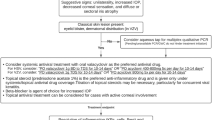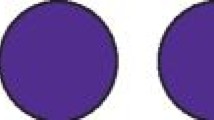Abstract
Data sources
The Cochrane Central Register of Controlled Trials, Cochrane Database of Systematic Reviews, Medline and Embase databases were searched together with the reference lists of primary studies, commentaries and reviews. Grey literature resources including the System for Information on Grey Literature in Europe, the Scopus Web and Patent searches, Proquest Dissertations and Theses Fulltext, the Index to Scientific and Technical Proceedings and the clinical trials registry (http://clinicaltrials.gov) were also searched.
Study selection
Randomised controlled trials (RCTs) involving nucleoside antiviral agents for the prevention of recurrent oral herpes in healthy immunocompetent subjects ≥12 years old were included. No language restrictions were applied. Study quality was assessed following Cochrane guidelines.
Data extraction and synthesis
Data were abstracted using a standardised data extraction form and analysed with meta-analysis carried out only with studies that reported the same outcome measure.
Results
Ten studies were included, only one study was considered to have a low risk of bias, five an unclear risk and four a high risk of bias. Oral acyclovir (800-1,600 mg daily) and valacyclovir (500 mg daily for four months) were shown to be effective in the prevention of RHL when taken prior to the appearance of any symptoms or exposure to triggers.
Conclusions
This review found support for the use of systemic acyclovir and valacyclovir for the prevention of RHL. However, the findings from this review should be interpreted with caution, because the methodologic assessment of the quality of the included studies showed an unclear risk of bias in five out of the ten included papers, and a high risk of bias in four studies.
Similar content being viewed by others
Commentary
Even with the extensive research efforts worldwide in the battle against herpes simplex virus (HSV), it remains a highly prevalent epidemic disease. Ninety percent of the population has been exposed to the virus as stated in the review and previous publications.1,2 Twenty to thirty percent of those previously infected patients experience an episode of reactivation of the latent virus as recurrent herpes labialis (RHL) after exposure to triggers such as fever, trauma and stress.3
As has been reported, RHL is a self-limiting infection, however discomfort varies and frequency can affect the quality of life of patients during the period of acute infection.
Various formulations of nucleoside antiviral agents have been developed since the 1980s for the treatment of RHL and since then the development of different strategies to treat and eradicate the virus has been a global health priority. The topic of this review is relevant to assess the efficacy of the various formulations in the treatment and prevention of RHL. For this systematic review an extensive search with a broad search strategy which included three electronic databases, hand searching, reference lists and grey literature with no language barriers was done to appropriately look for randomised clinical trials addressing the therapy question proposed by the authors.
Inclusion and exclusion criteria were clearly listed. Ten studies were finally selected which met the inclusion criteria. A quality assessment using standardised tools was performed and it was determined that only one study had a low risk of bias. From the ten studies seven were parallel groups and three were crossover studies comparing different formulations of antivirals. There were seven studies of acyclovir versus placebo (topical and systemic), one for valcyclovir versus placebo and one for famcyclovir versus placebo.
Heterogeneity was calculated examining the type of intervention and the outcome measure. Due to the high heterogeneity calculated, subgroup analysis was done for each pharmacological intervention. The results from the review show that there is a statistically significant difference in favour of systemic antiviral agents (R.R. 0.70, 95% C.I. 0.55-0.89) such as oral acyclovir 800-1600 mg daily and valcyclovir 500mg daily for four months. Famcyclovir showed no effect compared to placebo. The most common side effects reported by both treatment and placebo groups were headache and nausea.
Patients across various studies were exposed to different triggers and protocols (such as different time and dosage of application). All the studies compared an antiviral drug with placebo. None of them compared one antiviral drug regimen to another. Based on the results it seems there is a small benefit to using systemic antivirals for the prevention of RHL, however future RCTs with more standardised protocols and outcomes will be valuable in assessing the efficacy and thereby the recommendation of antivirals agents.
References
Chayavichitsilp P, Buckwalter JV, Krakowski AC, Friedlander SF . Herpes simplex. Pediatr Rev. 2009; 30: 119–129.
Wilson SS, Fakioglu E, Herold BC . Novel approaches in fighting herpes simplex virus infections. Expert Rev Anti Infect Ther. 2009; 7: 559–568.
McCarthy JP, Browning WD, Teerlink C, Veit G . Treatment of herpes labialis: comparison of two OTC drugs and untreated controls. J Esthet Restor Dent. 2012; 24: 103–109.
Author information
Authors and Affiliations
Additional information
Address for correspondence: R. Bohay Schulich School of Medicine and Dentistry, University of Western Ontario, London, Canada. E-mail: richard.bohay@schulich.uwo.ca
Rahimi H, Mara T, Costella J, Speechley M, Bohay R. Effectiveness of antiviral agents for the prevention of recurrent herpes labialis: a systematic review and meta-analysis. Oral Surg Oral Med Oral Pathol Oral Radiol. 2012; 113: 618–627.
Rights and permissions
About this article
Cite this article
Wong, Y., Veitz-Keenan, A. Systemic nucleoside antiviral agents may be effective in prevention of recurrent herpes labialis. Evid Based Dent 14, 54 (2013). https://doi.org/10.1038/sj.ebd.6400937
Published:
Issue Date:
DOI: https://doi.org/10.1038/sj.ebd.6400937



